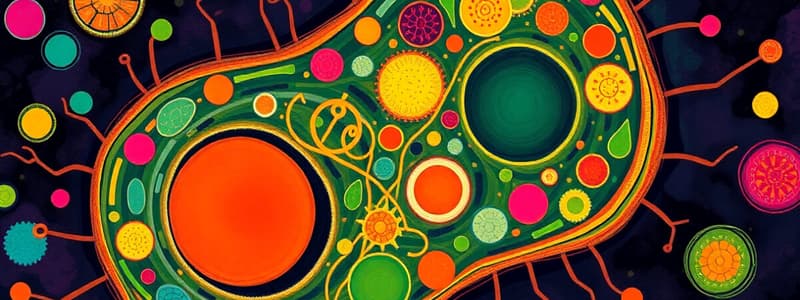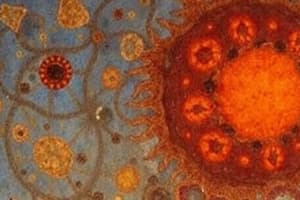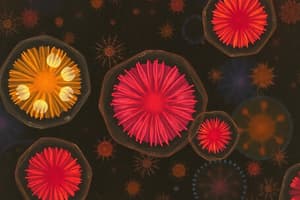Podcast
Questions and Answers
A researcher observes a protein being transported into the nucleus of a cell. Which characteristic would MOST likely facilitate this transport?
A researcher observes a protein being transported into the nucleus of a cell. Which characteristic would MOST likely facilitate this transport?
- The protein is transported via dynein motor proteins.
- The protein has a strong hydrophobic region that allows it to slip through the lipid bilayer.
- The protein is small enough to passively diffuse through the nuclear pores.
- The protein possesses a nuclear localization signal (NLS). (correct)
In a cell with a compromised endomembrane system, which process would be MOST directly affected?
In a cell with a compromised endomembrane system, which process would be MOST directly affected?
- ATP production in the mitochondria.
- Chromosome segregation during cell division.
- Vesicle transport between organelles. (correct)
- Diffusion of small molecules across the plasma membrane.
Which cellular component dictates the destination of a newly synthesized protein within a eukaryotic cell?
Which cellular component dictates the destination of a newly synthesized protein within a eukaryotic cell?
- The protein's tertiary structure.
- The abundance of chaperone proteins in the cytoplasm.
- The size of the protein.
- The presence of a signal sequence on the protein. (correct)
If a cell were treated with a drug that inhibits the function of dynein, what cellular process would be MOST directly affected?
If a cell were treated with a drug that inhibits the function of dynein, what cellular process would be MOST directly affected?
A muscle cell requires a significant amount of energy to function properly. Which organelle would you expect to be MOST abundant in muscle cells compared to other cell types?
A muscle cell requires a significant amount of energy to function properly. Which organelle would you expect to be MOST abundant in muscle cells compared to other cell types?
Which of the following statements accurately reflects a key tenet of cell theory?
Which of the following statements accurately reflects a key tenet of cell theory?
A scientist observes a cell under a microscope and notes the absence of a nucleus. Which of the following classifications is most likely?
A scientist observes a cell under a microscope and notes the absence of a nucleus. Which of the following classifications is most likely?
Which of the following eukaryotic organelles is primarily involved in the synthesis of lipids and detoxification of drugs and alcohol?
Which of the following eukaryotic organelles is primarily involved in the synthesis of lipids and detoxification of drugs and alcohol?
In eukaryotic cells, compartmentalization offers a significant advantage. Which of the following is the most direct consequence of the compartmentalization?
In eukaryotic cells, compartmentalization offers a significant advantage. Which of the following is the most direct consequence of the compartmentalization?
If a cell needs to transport a protein to the cell periphery, which motor protein and cytoskeletal element would be involved?
If a cell needs to transport a protein to the cell periphery, which motor protein and cytoskeletal element would be involved?
Which of the following structures is found in both prokaryotic and eukaryotic cells?
Which of the following structures is found in both prokaryotic and eukaryotic cells?
A researcher is studying the movement of vesicles within a cell. They observe that the vesicles are moving toward the cell membrane. Which motor protein is most likely responsible for this movement?
A researcher is studying the movement of vesicles within a cell. They observe that the vesicles are moving toward the cell membrane. Which motor protein is most likely responsible for this movement?
What is the primary function of the cell wall in prokaryotic cells?
What is the primary function of the cell wall in prokaryotic cells?
Flashcards
Dynein
Dynein
A motor protein that moves cargo towards the minus end of microtubules, directing it towards the cell center.
Mitochondria (in high-energy cells)
Mitochondria (in high-energy cells)
Organelles that generate energy. Cells needing more energy contain more of these.
Signal Sequences
Signal Sequences
Short sequence that directs proteins to their correct location within or outside the cell.
Nuclear Localization Signal (NLS)
Nuclear Localization Signal (NLS)
Signup and view all the flashcards
Vesicle Transport
Vesicle Transport
Signup and view all the flashcards
Cell Theory
Cell Theory
Signup and view all the flashcards
Why are cells so small?
Why are cells so small?
Signup and view all the flashcards
Prokaryotic Cells
Prokaryotic Cells
Signup and view all the flashcards
Eukaryotic Cells
Eukaryotic Cells
Signup and view all the flashcards
Nucleoid
Nucleoid
Signup and view all the flashcards
Compartmentalization Benefits
Compartmentalization Benefits
Signup and view all the flashcards
Function of Nucleus
Function of Nucleus
Signup and view all the flashcards
Microfilaments function
Microfilaments function
Signup and view all the flashcards
Study Notes
- Chapter 7 explores the cell and its functions
Cell Theory
- All organisms consist of cells
- All cells come from pre-existing cells
Cell Size
- Small cell size allows efficient nutrient and waste exchange through the cell membrane
Cell Types
- Prokaryotic cells lack a nucleus and are simpler, examples include bacteria and archaea like E. coli
- Eukaryotic cells possess a nucleus and are more complex, examples include plants, animals, fungi, and protists, such as human liver cells
Prokaryotic Cell Structure
- Nucleoid: contains DNA
- Ribosomes: responsible for protein synthesis
- Plasma Membrane: selective barrier
- Cell Wall: structural support
- Flagella: facilitates movement
Compartmentalization in Eukaryotic Cells
- Increases efficiency by isolating biochemical processes
Key Organelles and Their Functions
- Nucleus: information storage and processing
- Ribosomes: protein synthesis
- Vacuoles: storage and waste disposal
- Peroxisomes: fatty acid metabolism and detoxification
- Mitochondria: ATP (energy) production
- Chloroplasts: photosynthesis (only in plant cells)
Endomembrane System
- Rough ER: protein synthesis and modification
- Smooth ER: lipid synthesis and detoxification
- Golgi Apparatus: protein modification and sorting
- Lysosomes: breakdown of macromolecules
- Vesicles: transport of materials
Cytoskeleton Components
- Microfilaments: composed of actin subunits, maintain cell shape and enable movement
- Intermediate Filaments: consists of various proteins and provides structural support
- Microtubules: composed of tubulin subunits, facilitate cell division and intracellular transport
Motor Proteins
- Kinesin: moves towards the cell periphery (plus end of microtubules), transports cargo outward
- Dynein: moves towards the cell center (minus end of microtubules), transports cargo inward
Organelles and Cell Function
- Cells with high energy demands have numerous mitochondria
Transport Across Nuclear Envelope
- Small molecules diffuse through nuclear pores
- Large proteins require a Nuclear Localization Signal (NLS) for transport
Endomembrane System
- Organelles communicate via vesicle transport for protein and lipid processing
Protein Sorting
- Signal sequences direct proteins to their correct locations
Cytoskeleton Dynamics
- Microtubules and microfilaments continuously assemble and disassemble
- Motor proteins transport cargo along cytoskeletal elements
Studying That Suits You
Use AI to generate personalized quizzes and flashcards to suit your learning preferences.
Description
Explore the fundamental concepts of cell biology, including cell theory, size, and types (prokaryotic and eukaryotic). Examine the organelles within cells, such as the nucleus, ribosomes, and vacuoles, and their functions.




